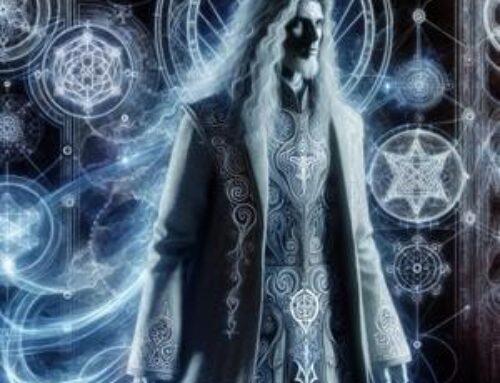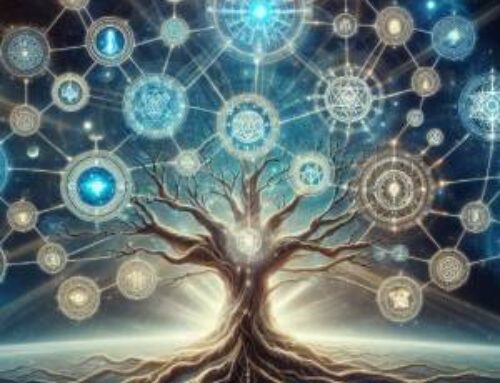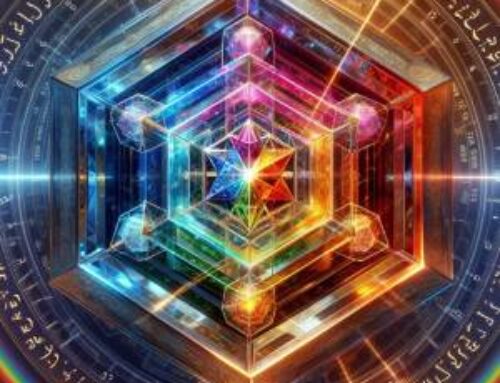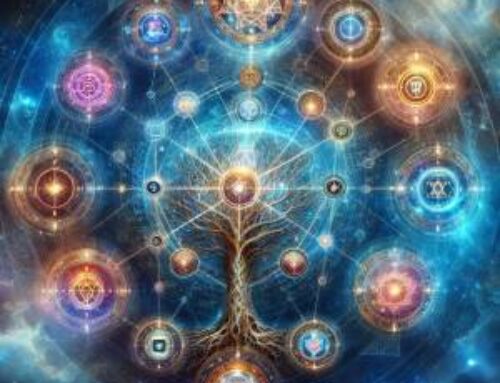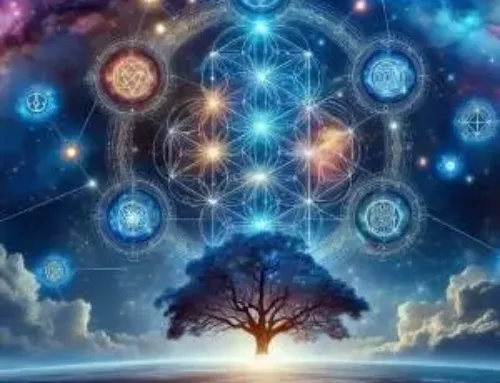Contents
Introduction to Merkabah Kabbalah
In the intricate mosaic of western mystical traditions, Merkabah Kabbalah emerges as a profound and mysterious conduit to divine ascension. Derived from the Hebrew term for ‘chariot,’ Merkabah mysticism embarks the seeker on a profound journey through celestial spheres, anchored by the ancient texts and the visionary experiences of the prophet Ezekiel. This introduction aims to delve into the historical origins, symbolic complexities, and practical methodologies that today’s mystics can adopt to navigate these transcendent realms.

The primal tradition of the one and only revelation has been preserved under the name of Kabbalah by the priesthood of Israel (1).
Merkabah Kabbalah not only constructs a sophisticated framework for deciphering the cosmic architecture but also equips initiates with the means to encounter the Divine directly. It marries stringent meditative disciplines with rich theological narratives, creating an intricate blend of metaphysical contemplation and mystical communion. Through this discourse, we aim to reveal the arcane secrets of the Merkabah, shedding light on its integral role within the vast tapestry of Kabbalistic wisdom and its enduring significance to contemporary spiritual endeavors.
Understanding Merkabah Kabbalah
The Essence and Foundations of Merkabah Mysticism
Merkabah Kabbalah, a profound pillar within western mystical traditions, embodies the esoteric pathway to divine ascension. This mystical discipline centers around the Merkabah, or “chariot,” a concept derived from the apocalyptic visions of the prophet Ezekiel, as described in his biblical book. Here, the Merkabah is depicted as the throne-chariot of God, surrounded by awe-inspiring angelic beings and a complex, fiery assembly.
Historical Context and Evolution
Kabbalists delved into special practices, meditation, and the deciphering of angelic scripts to traverse the seven heavens and ultimately witness the divine throne. This ascension was not merely about spiritual sightseeing but involved intense preparation and purification, signifying a mystic’s journey towards spiritual perfection and enlightenment. The Hekhalot and Merkavah literature, which emerged prominently during this period, provides detailed methodologies and experiences of those who journeyed through the celestial realms, revealing encounters with angels and direct communications with the divine.
Kabbalah is a mystical and intellectual branch of Judaism that, since the Middle Ages, has explored the mysteries of God, sought mystical union with God, and harnessed divine energy for the betterment of the world (2).
Merkabah’s Role in Kabbalistic Literature
In the broader scope of Kabbalistic literature, the Merkabah serves not only as a metaphysical object but also as a profound symbol of the mind’s ability to surpass the physical confines and engage with higher spiritual realities (3). Its depictions in various mystical texts highlight its role as a vehicle through which the soul ascends to divine proximity. The symbolism associated with the Merkabah—ranging from wheels within wheels, eyes all around, and the presence of the holy living creatures—reflects the complex metaphysical structures that underpin the Kabbalistic view of the universe.
The Historical Evolution of Merkabah Mysticism
Development through Antiquity
As these mystical practices evolved, they became more structured within the rabbinic traditions of the Mishnah and Talmud, where they were often guarded due to their intense, esoteric nature. The practitioners of Merkabah mysticism, often referred to as “descenders of the chariot,” were typically reserved for those of exemplary character and profound spiritual standing.
This period also saw the blending of philosophical inquiries into the nature of existence and the spiritual dimensions, with Merkabah mysticism offering a mystical framework that intertwined with early Gnostic and Christian mystical thoughts. This syncretism helped shape the contours of western mysticism, leading to the rich tapestry that would inform the Kabbalistic systems in medieval Spain and beyond.
Flourishing in Medieval Kabbalah
By the medieval period, particularly with the emergence of the Zohar and the writings of influential mystics like Isaac Luria, Merkabah mysticism was intricately woven into the fabric of Kabbalistic thought. It provided a cosmological blueprint that explained the dynamics of creation, the nature of divine emanations, and the process of spiritual redemption.
Symbols and Significance
Exploring the Symbolism of the Merkabah
The Merkabah, often depicted as a complex celestial chariot, embodies profound esoteric symbols within mystical traditions. Its structure, replete with wheels within wheels, and surrounded by holy creatures, each with multiple faces, serves as a metaphor for the universe’s multi-dimensional nature. These elements are not just artistic expressions but are imbued with deep metaphysical meanings.
Metaphysical Interpretations
The interlocking wheels, typically seen in visionary experiences, symbolize the cycles of creation and destruction, the perpetual motion of the cosmos, and the fluid nature of time and space. The creatures represent various forms of divine manifestation, each aspect revealing a unique facet of supreme consciousness. This symbolism extends to the throne above the Merkabah, signifying divine authority and the central point of cosmic harmony.
The Merkabah in Mystical Practices
In mystical practices, the Merkabah’s imagery is used as a focal point for meditation, aiding practitioners in transcending their physical surroundings to access higher states of consciousness. Through meditative journeys, adepts can explore these symbols, experiencing profound revelations about the universe’s structure and their place within it. Each element of the Merkabah teaches about balance, harmony, and the integration of different forces and energies.
Archetypes can be understood as culturally determined symbolic forms, organizing and structuring non-cognitive mental aspects of human life, rather than biologically inherited predispositions (4).
Practices and Meditations
Meditative Pathways to the Chariot
The practice of ascending the Merkabah involves detailed ceremonial and meditative techniques that facilitate the practitioner’s journey through celestial spheres. These techbniques are designed to purify the mind and align the soul with the frequencies of the higher realms, preparing the mystic for the profound experiences ahead.
Techniques and Rituals
Key techniques include visualization of the Merkabah, recitation of sacred hymns, and rhythmic breathing that mirrors the celestial order. Practitioners often visualize themselves within the Merkabah, traveling through the heavenly domains, meeting spiritual entities, and gaining insights into the nature of reality and existence. This experiential approach not only deepens their understanding but also enhances their spiritual wisdom.
Integration into Spiritual Practices
These meditative practices are integrated into a broader spiritual regimen that includes ethical living, moral introspection, and the cultivation of virtues. Such a holistic approach ensures that the mystical experiences are not just intellectual exercises but transformative processes that refine the practitioner’s entire being.
Merkabah Techniques as a Secret Path
Merkabah techniques represent a secretive aspect of the broader initiatory tradition within Western esoteric practices. Specifically, within the framework of the Tree of Life, Merkabah mysticism serves as the hidden path connecting Chesed (Mercy) to Binah (Understanding). This path symbolizes the profound journey of merging individuality with the divine soul, highlighting a crucial aspect of spiritual ascent and integration.
Conclusion
In the labyrinth of spiritual traditions, “Merkabah Kabbalah” emerges as a profound pathway, offering not just theoretical knowledge but a practical approach to experiencing the divine. The journey through the Merkabah’s mystical landscape is one of ascension and enlightenment, where the chariot becomes a conduit for profound spiritual realizations, linking the individual soul with the universal divine essence.
The exploration of Merkabah Kabbalah reveals its dual nature as both an ancient esoteric system and a living tradition that evolves and adapts to meet the needs of modern seekers. Through the symbolic understanding of the chariot—interconnecting the spheres of Chesed and Binah on the Tree of Life—practitioners navigate the complexities of their spiritual and material existence, aiming to harmonize their personal experiences with the universal truths of the cosmos.
This mystical tradition underscores a transformative journey that is both inward and upward, guiding individuals through the structured layers of celestial domains toward the ultimate union with the divine. It is a path shrouded in secrecy, requiring purity, dedication, and moral integrity from those who dare to traverse its sacred realms.
Build Your Higher Vehicles
For those intrigued by the mystical paths of the Hermetic Academy, “Merkabah Kabbalah” offers a unique glimpse into the esoteric practices that shape the contours of spiritual development. Engaging with this tradition is a transformative experience, prompting deeper introspection and personal evolution.
FAQ – Merkabah Kabbalah
1. What is Merkabah Kabbalah?
Merkabah Kabbalah is a mystical tradition, deeply rooted in the pursuit of ascending through the spiritual realms by the agency of the Merkabah, or divine chariot, as vividly revealed in the visions of the Prophet Ezekiel. This sacred journey engages the practitioner in complex meditations and rituals, all designed to usher one into the direct presence of the Divine, with the aim of achieving profound spiritual enlightenment.
2. How doth the Merkabah connect to the Tree of Life in Kabbalistic teachings?
Within the cosmology of Kabbalah, the Merkabah is seen as a mystical bridge, connecting Chesed (Mercy) to Binah (Understanding) upon the Tree of Life. This ethereal link doth signify the soul’s passage from the sphere of individual expression (Chesed) to the consummate realization of the Divine essence (Binah). It symbolizes a deep spiritual ascension and the blending of personal consciousness with the universal verities, proffering a path to transcendence and enlightenment.
3. What renders Merkabah Kabbalah distinct amongst mystical traditions?
Merkabah Kabbalah is uniquely characterized by its singular focus on the divine chariot as the vessel for spiritual ascension. Unlike other mystical pathways that may seek enlightenment or union with the Divine through diverse meditations or rites of initiation, Merkabah Kabbalah uniquely melds intricate symbolic visualizations with the active traversal of the celestial spheres. This distinctive method allows for a dynamic communion with the spiritual entities and forces encountered upon this transcendent journey.
4. Whither might one study Merkabah Kabbalah?
The Hermetic Academy stands as a venerable institution for those desirous of delving into the mysteries of Merkabah Kabbalah, amongst other mystical doctrines. It offers exhaustive courses that thoroughly expound upon both the elementary and advanced tenets of Merkabah Kabbalah. These scholarly programmes are thoughtfully devised to accommodate both the novitiate and the adept, all who yearn to broaden their spiritual understanding and attain greater depths of spiritual maturation.
References:
(1) Eliphas L. (1854). Dogme et Rituel de la Haute Magie. Paris, Frankreich.
(2) Tirosh-Samuelson, H. (2013). Kabbalah in Judaism. https://doi.org/10.1007/978-1-4020-8265-8_1519.
(3) Rubenstein, E. (2020). The Tree of Life: The Kabbalah of Immortality. Hermetic World, Paphos.
(4) Pietikainen, P. (1998). Archetypes as symbolic forms. Journal of Analytical Psychology, 43, 325-343. https://doi.org/10.1111/1465-5922.00032.

